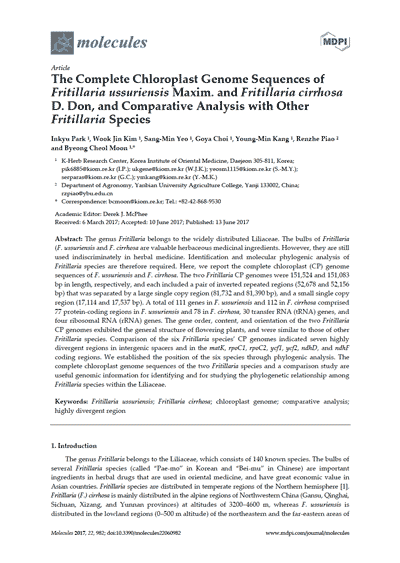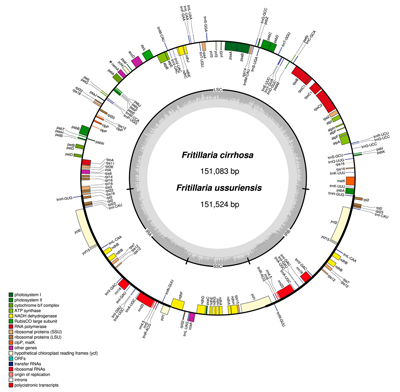NEWS 2017
The Complete Chloroplast Genome Sequences of Fritillaria ussuriensis Maxim. and Fritillaria cirrhosa D. Don, and Comparative Analysis with other Fritillaria Species
Inkyu PARK¹, Wook-Jin KIM¹, Sang-Min YEO¹, Goya CHOI¹, Young-Min KANG¹, Renzhe PIAO², Byeong-Cheol MOON¹
Molecules 22(6): 982 (2017)
doi:10.3390/molecules22060982
¹K-herb Research Center, Korea Institute of Oriental Medicine, Daejeon 305-811, Republic of Korea
²Department of Agronomy, Yanbian University Agriculture College, Yanji 133002, China
Abstract
The genus Fritillaria belongs to the widely distributed family Liliaceae. The bulbs of Fritillaria ussuriensis and Fritillaria cirrhosa are valuable herbaceous medicinal ingredients. However, they are still used indiscriminately in herbal medicine. Identification and molecular phylogenic analysis of Fritillaria species is therefore required. Here, we report the complete chloroplast (cp) genome sequences of F. ussuriensis and F. cirrhosa. The two Fritillaria cp genomes were 151,524 and 151,083 bp in length, respectively, including a pair of inverted repeat regions (52,678 and 52,156 bp) separated by a large single copy region (81,732 and 81,390 bp) and small single copy region (17,114 and 17,537 bp). A total of 111 genes in F. ussuriensis and 112 in F. cirrhosa comprised 77 proteincoding genes in F. ussuriensis and 78 in F. cirrhosa, 30 tRNA genes, and four rRNA genes. The gene order, content, and orientation of the two Fritillaria cp genomes exhibited the general structure of flowering plants, and were similar to those of other Fritillaria species. Comparison of the six Fritillaria species’ cp genomes indicated seven highly divergent regions in intergenic spacers and in the matK, rpoC1, rpoC2, ycf1, ycf2, ndhD, and ndhF coding regions. We established the position of the six species through phylogenic analysis. The complete chloroplast genome sequences of two Fritillaria species will be useful genomics resources for identification of Fritillaria species and for studying the phylogenetic relationship among Fritillaria species within the Liliaceae family.





